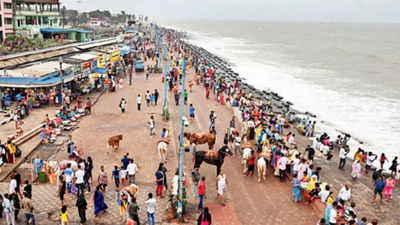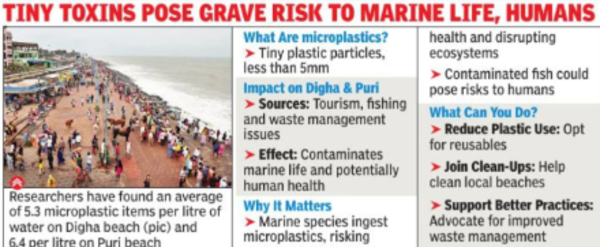[ad_1]

KOLKATA: The one-use plastic bag that you simply left on the Digha seashore final summer season would possibly nonetheless be there however in a really completely different – and far more dangerous – kind.

A latest research – funded by the Centre’s Science & Engineering Analysis Board – has discovered alarming ranges of microplastics within the coastal waters and sediments of Digha and Puri, two of jap India’s hottest seashore locations.It highlights severe considerations concerning the affect of microplastics on marine life and the well being of hundreds of thousands of tourists.
Researchers discovered a mean of 5.3 microplastic gadgets per litre of water on the Digha seashore and 6.4 microplastic gadgets per litre on the Puri seashore. The sediments revealed much more troubling knowledge, with Digha recording 173.4 gadgets per kg and Puri reaching 190.4 gadgets per kg. These numbers counsel that plastic air pollution is a rising disaster in these coastal areas, doubtlessly affecting the way forward for these vacationer spots.
“The invention of such alarmingly excessive microplastic ranges within the waters and sediments of Digha and Puri is a wake-up name,” author Amitav Ghosh, a distinguished voice within the discourse on ecology and local weather change, stated. “This poses a grave menace to the fragile marine ecosystem, with potential penalties for the numerous creatures that decision these waters residence. It additionally compromises vacationers’ security and well being as microplastics can enter the meals chain. We’d like pressing motion,” he added.
Microplastics are tiny plastic particles lower than 5mm in dimension, originating from stuff like polythene luggage, bottles, microbeads in private care merchandise, cigarette filter ideas, artificial materials, automobile tyres, industrial waste, fishing gear and paints. The research recognized polyethylene, a standard plastic utilized in luggage and packaging, as probably the most prevalent kind of microplastic. It poses important threat to marine life due to its abundance and persistence within the setting, say scientists concerned with the research.
‘Microplastic menace to fish, seabirds, turtles’
Marine creatures usually mistake microplastics for meals, which might trigger bodily hurt, blockages and publicity to poisonous chemical compounds; fish, sea turtles and seabirds are significantly weak. Microplastics can even carry dangerous chemical compounds absorbed from surrounding water. Vacationers and locals in Digha and Puri may additionally ingest microplastics whereas having their favorite seafood dish, resulting in potential well being points.
“Fisherfolk usually catch extra plastic than fish of their nets and discover plastic contained in the fish or lifeless fish trapped in polythene packets. Microplastics have an effect on fish copy, decreasing fish populations and impacting customers and fishermen. Moreover, uncontrolled tourism growth from Haldia to Puri and direct launch of commercial effluents into rivers contribute to this downside,” Dakshinbanga Matsyajibi Discussion board president Debashis Shyamal stated.
“The staggering ranges of microplastic air pollution in coastal waters and sediments of Digha and Puri are stark reminders of the urgency to scale back our plastic utilization,” Balram Ambade of NIT Jamshedpur, co-author of the paper, stated.
[ad_2]
Source link
This Publish might comprise copywrite


